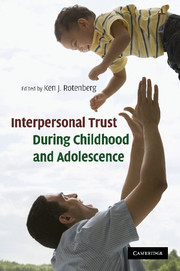Book contents
- Frontmatter
- Contents
- List of figures
- List of tables
- List of contributors
- Section I Conceptual foundations and issues
- 1 Introduction
- 2 The conceptualization of interpersonal trust: A basis, domain, and target framework
- 3 Neurobiology of interpersonal trust
- 4 Children's sense of trust in significant others: Genetic versus environmental contributions and buffer to life stressors
- Section II Childhood
- Section III Adolescence and early adulthood
- Index
- References
4 - Children's sense of trust in significant others: Genetic versus environmental contributions and buffer to life stressors
Published online by Cambridge University Press: 04 August 2010
- Frontmatter
- Contents
- List of figures
- List of tables
- List of contributors
- Section I Conceptual foundations and issues
- 1 Introduction
- 2 The conceptualization of interpersonal trust: A basis, domain, and target framework
- 3 Neurobiology of interpersonal trust
- 4 Children's sense of trust in significant others: Genetic versus environmental contributions and buffer to life stressors
- Section II Childhood
- Section III Adolescence and early adulthood
- Index
- References
Summary
The capacity to form trusting relationships is regarded as essential to the development and maintenance of healthy social relationships (Gurtman, 1992). Furthermore, trusting relationships and individuals' sense of trust regarding those relationships have been found to serve important psychosocial functions, such as promoting reciprocal cooperation in interpersonal exchanges (Deutsch, 1958, 1960; Rapaport and Orwant, 1962). Erikson (1963) was a pioneer in recognizing the importance of trust in early life. He argued that individuals' ability to establish basic trust with the significant others who care for them affects their psychological functioning throughout their life-span. Erikson (1963) viewed basic trust as encompassing an individual's sense that he or she can trust others and his or her confidence that he or she has the ability to form a relationship.
A similar perspective on the role of trust in interpersonal trust to that held by Erikson emerges from the attachment theory advanced by Bowlby (1969, 1973). Bowlby (1969) proposed that attachment is the emotional bond between an infant and its significant other (i.e., caregiver) and that the security of that bond substantively affects social functioning during the course of development. These principles guided the seminal work by Ainsworth and her colleagues (e.g., Ainsworth, Blehar, Waters, and Wall, 1978), as well as others.
The primary mechanism for the link between the attachment bond and social development is the internal working model (IWM).
- Type
- Chapter
- Information
- Interpersonal Trust during Childhood and Adolescence , pp. 56 - 84Publisher: Cambridge University PressPrint publication year: 2010
References
- 7
- Cited by



